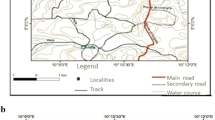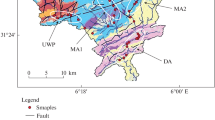Abstract
Mineralogical, chemical, and geological aspects of four types of clay deposits in Las Aguilas Formation northwest of Barker in Buenos Aires Province, Argentina, indicate that these products of lateritic alteration of Precambrian granite are predominantly kaolinitic with minor amounts of halloysite, illite, and chlorite. Minor amounts of quartz, feldspars, and ferric oxides are also present. Of the four types, one is suitable for high quality refractories, another can be used for wall tiles and china, and a third, the most abundant, can be used for red ceramics; the fourth has no special use. The abundance of the clays is calculated to exceed eleven million metric tons.
Резюме
Минералогические, химические, и геологические аспекты четырех видов отложений глин формаций Лас Агулас к северо-западу от Баркер в провинций Буэнос Айрес, Аргентина, указывают, что эти продукты латеритового выветривания докембрийского гранита являются в основном каолинитовыми с небольшими количествами галлоизита, иллита, и хлорита. Также присутствуют небольшие количества кварца, полевого шпата, и окисей железа. Из четырех типов глин один может использоваться для изготовления высококачественных огнеупоров, другой-для изготовления кафеля и фарфора, третий, самый распостраненный, — для изготовления красной керамики, четвертый не подходит для никакого специального употребления. Вычисленные запасы превышают одиннадцать миллионов метрических тонн.
Resümee
Mineralogische, chemische, und geologische Aspekte von vier Arten von Tonablagerungen in Las Aguilas Formation nordwestlich von Barker im Buenos Aires Bezirke Argentinien, deuten an, daß diese Produkte lateritischer Veränderung von precambrischem Granit zumeist aus Kaolin mit ein wenig Halloysit, Mit, und Chlorit bestehen. Kleinere Mengen von Quartz, Feldspaten, und Eisen (III) oxyden sind auch vorhanden. Von den vier Tonarten ist eine für hochqualitäts Schamottestein verwendbar, eine andere kann für Wandkacheln und Geschirr benutzt werden, eine dritte, die am meisten vorkommende, kann für rote Keramik benutzt werden, und die vierte hat keinen besonderen Nutzen. Das Vorkommen der Tonerden ist auf über elf Millionen Tonnen berechnet worden.
Résumé
Les aspects minéralogiques, chimiques, et géologiques de quatre sortes de dépôts d’argile de la formation Las Aguilas du nord ouest de la province de Buenos Aires, Argentine, indiquent que ces produits d’altération latérique de granite Précambrien sont en majeure partie kaolinitiques avec des quantités moindres d’halloysite, d’illite, et de chlorite. De petites quantités de quartz, de feldspar, et d’oxides ferriques sont aussi présentes. Parmi ces quatre sortes, une peut être utilisée pour des réfractaires de haute qualité, une autre pour des tuiles murales et la faience, et une troisième, la plus abondante, pour des céramiques rouges; la quatrième n’a aucune utilité particulière. L’abondance des argiles est calculée être en excès de onze millions de tonnes métriques.
Similar content being viewed by others
References
Almeida, de F. F. Ma. (1944) Coilenia itaperensis sp. novo fossil precámbrico do estado do Sao Paulo: Univ. Sao.Paulo. Fac. Fil. Cienc. Letras. Boletín Geológicol. 45, 86–106.
Amaral, G. and Kawashita, K. (1967) Determinaçao da idade do Grupo Bambui pelo método Rb/Sr: Boletin Paranaense de Geociencias Curitiba 26, 214–217.
Arnos, A., Quartino, B., and Zardini, R. (1972) Grupo “La Tinta.” (Provincia de Buenos Aires, Argentina. ¿Paleozóico o Precámbrico?: Anales XXV Congreso Brasileño de Geología, Sao Paulo, 211–221.
Angelelli, V., Villa, R., and Suriano, J. M. (1973) Recursos minerales y rocas de aplicacion de la Provincia de Buenos Aires: Revista Anales LEMIT 2, Ministerio de Obras Públicas de la Provincia de Buenos Aires, La Plata, Argentina, 14 pp.
Bonhomme, M. and Cingolani, C. (1978) Rb/Sr and K/Ar dating of Upper Precambrian sediments of the “Serie de La Tinta,” Buenos Aires Province, Argentina: Short papers of the Fourth International Conference, Geochronology, Cosmochronology, Isotope Geology, U.S. Geol. Survey, Open-File Report 78–701, 45–46.
Borrello, A. V. (1966) Trazas, restos tubiformes y cuerpos fósiles problemáticos de la Formación La Tinta. Sierras Septeutrionales de la Provincis de Buenos Aires: Com. Inv. Cient. Prov. Buenos Aires, Paleon. Bon. 5, 1–42.
Caillère, S. and Iñiguez Rodriguez, A. M. (1967) Étude minéralogique de “La Tinta” formation argileuse de la Province de Buenos Aires, République Argentine: Bull. Soc. Fr. Cristallogr. 90, 246–251.
Dalla Salda. L. and Iñiguez Rodriguez, A. M. (1978) La Tinta, Precámbrico y Paleozoico de Buenos Aires: Resumenes del VII Congreso Geológico Argentino en Diciembre 1977, Neuquen, p. 18 (abstract).
Di Paola, E. and Marchese, H. G. (1974) Relatión entre la tectosedimentación, litología y mineralogía de arcillas del Complejo Buenos Aires y la Formatión La Tinta. (Provincia de Buenos Aires): Revista de la Asociación Argentina de Mineralogía, Petrología y Sedimentología 5, 45–57.
Gonzalez Bonorino, F. and Teruggi, M. E. (1952) Léxico Sedimentológico: Museo Arg. Ciencias Naturales Bernardino Rivadavia, Publ. Ext. Cuit. Didáct. Buenos Aires, 164 pp.
Heusser, J. C. and Claráz, G. (1863) Ensayo de un conocimiento geognóstico fisico de la Provincia de Buenos Aires. I. La cordillera entre Cabo Corrientes y Tapalqué: Imprenta del Orden, Buenos Aires, 1–20.
Hey, M. H. (1954) New review of the chlorites: Mineral. Mag. 30, 277–292.
Holmberg, E. (1972) Tandilia: Geologia Regional Argentina, Academia National de Ciencias (Córdoba), 365–393.
Iniguez Rodriguez, A. M. (1965) Mineralogia de algunos yacimientos de arcillas de la Provincia de Buenos Aires: Tesis Doctoral, Facultad de Ciencias Naturales y Museo de La Plata, 89 pp.
Iniguez Rodriguez, A. M. and Zalba, P. E. (1974) Geología de yacimientos de arcillas refractarias de la Provincia de Buenos Aires: Revista de la Asociación Geológica Argentina (RAGA) 29, 304–310.
Johns, W. D., Grim, R. E., and Bradley, W. F. (1954) Quantitative estimations of clay minerals by diffraction methods: J. Sediment. Petrol. 24, 242–251.
Rabassa, J. (1973) Geologia superficial de la Hoja “Sierras de Tandil” Provincia de Buenos Aires: Revista Anales LEMIT, Serie II, 240, Ministerio de Obras Públicas de la Provincia de Buenos Aires, La Plata, Argentina, 117–160.
Rock Color Chart (1963) Prepared by The Rock Color Chart Committee, represented by: U.S. Geol. Surv.; Geol. Soc. Amer.; Amer. Assoc. Petrol. Geol.; Soc. Econ. Geol.; Assoc. Amer. State Geol., Printed in the Netherlands by Huyskes-Enschede.
Teruggi, M. E. (1951) Contributión a la petrología del Partido de Tandil, el cerro Noceti, Provincia de Buenos Aires: Mus. Arg. “Bernardino Rivadavia,” III Geol. 1, 1–53.
Teruggi, M. E. (1964) Paleocorrientes y paleogeografia de la Seriede La Tinta (Provincia de Buenos Aires): Com. Invest. Cient. An. 5, 1–27.
Teruggi, M. E. and Kilmurray, J. D. (1975) Tandilia. Relatorio geología de la Provincia de Buenos Aires: VI Congreso Geol. Arg. Bahia Bianca, 55–77.
Teruggi, M. E., Kilmurray, J. D., and Dalla Salda, L. (1973) Los dominios tectónicos de la región de Tandil: An. Soc. Cient. Argent. 195, 81–94.
Teruggi, M. E., Maurino, V. E., and Limousin, T. (1962) Geología de la portión oriental de las Sierras de Tandil: An. las. Jorn. Geol. Arg. (San Juan 1960). II, 359–373 (Buenos Aires).
Teruggi, M. E., Mauriño, V. E., Limousin, T., and Schauer, O. (1968) Geología de las Sierras de Tandil: Rev. Asoc. Geol. Argent. 13, 185–204.
Zalba, P. E. (1978a) Sobre la presencia de diasporo y halloysita en las arcilitas de la zona de Barker, Provincia de Buenos Aires: Resumenes del VII Congreso Geológico Argentino, Diciembre 1977 (Neuquén), p. 64 (abstract).
Zalba, P. E. (1978b) Estudio geológico-económico de los yacimientos de arcillas de la zona de Barker, Partido de Juarez, Provincia de Buenos Aires y su importancia económica: Tesis Doctoral, Facultad de Ciencias Naturales y Museo de La Plata, 175 pp.
Author information
Authors and Affiliations
Rights and permissions
About this article
Cite this article
Zalba, P.E. Clay Deposits of Las Aguilas Formation, Barker, Buenos Aires Province, Argentina. Clays Clay Miner. 27, 433–439 (1979). https://doi.org/10.1346/CCMN.1979.0270607
Received:
Accepted:
Published:
Issue Date:
DOI: https://doi.org/10.1346/CCMN.1979.0270607




